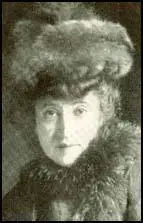Gladys Storey

Gladys Storey, the daughter of the artist, Graham Storey, was born in 1897. She became an actress and in 1910 her father introduced her to Charles Edward Perugini and Kate Dickens Perugini .
After the First World War Storey abandoned her career as an actress and became a writer. She renewed her relationship with Kate with the intention of writing a biography of her father, Charles Dickens. Over the next few years Gladys and her mother were regular visitors to Kate's home in Chelsea.
Lucinda Hawksley, the author of Katey: The Life and Loves of Dickens's Artist Daughter (2006), has pointed out: "For the last nine years of Kate's life, the Storeys would visit every Sunday, if possible, and occasionally on other days as well, to take tea with the elderly artist. Kate's family, in particular Henry and Marie, had mixed feelings about it. My great-uncle Eric used to complain that Gladys and her mother had monopolized Kate, turning her against her family, and that no one was able to see Kate on her own, as one or other of the ubiquitous Storeys was always visiting... Gladys's papers and diaries demonstrate genuine feelings for Kate, but there is also a particularly unpleasant element: Gladys's grasping eagerness to accept presents, especially family memorabila... Gladys's own notes record how she would turn up with a present for Kate - some flowers or a cake - and how Kate would then begin searching her rooms for a gift, feeling obliged to give her a present in return."
At some point Kate Dickens Perugini asked Storey to write her biography. She gave her some detailed interviews but stipulated book should not be published until after Henry Fielding Dickens and she had died. Kate spoke openly about her father's relationship with Ellen Ternan: "Nelly was a small fair-haired pretty actress... She had brains, which she used to educate herself, to bring her mind more on a level with his own. Who could blame her? He had the world at his feet. She was a young girl of eighteen, elated and proud to be noticed by him." She also admitted that she felt guilty about not staying with her mother, Catherine Dickens, "we were all wicked not to take her part."
Kate argued: " My father was like a madman... This affair brought out all that was worst - all that was weakest in him. He did not care a damn what happened to any of us. Nothing could surpass the misery and unhappiness of our home. " She added: " My father was a wicked man - a very wicked man... I loved my father better than any man in the world - in a different way of course... I loved him for his faults."
Kate Dickens Perugini died on 9th May 1929. Storey published her book, Dickens and Daughter in 1939. Supporters of Charles Dickens attacked the book as being unreliable, especially the passages about Ellen Ternan and the birth of a child. However, George Bernard Shaw, wrote to The Times Literary Supplement to say that Kate had told him everything in the book forty years before."
Gladys Storey died in 1964.
Primary Sources
(1) Lucinda Hawksley, Katey: The Life and Loves of Dickens's Artist Daughter (2006)
For the last nine years of Kate's life, the Storeys would visit every Sunday, if possible, and occasionally on other days as well, to take tea with the elderly artist. Kate's family, in particular Henry and Marie, had mixed feelings about it. My great-uncle Eric used to complain that Gladys and her mother had monopolized Kate, turning her against her family, and that no one was able to see Kate on her own, as one or other of the ubiquitous Storeys was always visiting...At some point during their friendship, Kate asked Gladys to writer her biography. It was, she stipulated, not to be published until after her own and Henry's deaths.
(2) Gladys Storey, Dickens and Daughter (1939)
Katie and her sister occupied a garret-room at the top of the house, in which they were free to do what they pleased in the way of arrangement and decoration, and were permitted to indulge in their separate tastes in the choice of prints, which they pinned unframed to the walls-so long as the room was kept tidy and neat. This neatness also applied to their drawers, which their father periodically inspected-at one time every day-in common with his visits to other rooms in the house - and if their contents were not found to be in apple-pie order, they quickly had to be rendered so.
